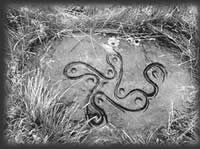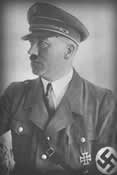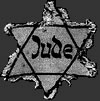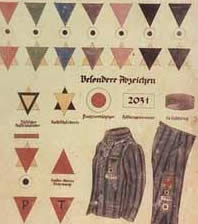
The
cross of St Bridget, talisman
of protection and prosperity

Swastika stone, West Yorkshire
For
thousands of years before the Nazis claimed this symbol as their
own, it had been used across a wide variety of cultures. The word swastika comes
from the Sanskrit svasti, which can be roughly translated
as “conducive to well being”, su, meaning ‘good’ and asti, ‘to
be’.
Unfortunately, for many people alive today, the swastika has no such positive connotation. The Nazis chose it to represent all that was noble and pure in their ideal of a ‘master race’; instead it serves as a reminder of their unspeakable brutality, and the terror they inflicted on those they labeled as ‘other’ and expendable.
[T]he
sacred expresses itself through something other than itself;
it appears in things, myths or symbols, but never wholly or directly.
Mircea Eliade [2]
In the passage quoted above, Eliade was referring to the various means human beings have used to represent that which they define as ‘sacred’, a quality perceived to be at times within objects and phenomena, and at others—as in the quote—considered to be wholly ‘other’. The divine—like the light of the sun, or the power of an atomic explosion—is considered too awesome—too overwhelming—to be confronted directly. It requires therefore a suitable vessel in which it can be contained, and this is the true power of symbol and myth.[3] For at the same time as these products of spirit and imagination are capable of carrying this power, there is no one interpretation or explanation—no ultimate translation—that can diminish their capacity to inspire.
One of the oldest of humankind’s religious symbols is the swastika, an image that appears in prehistoric times, and which has been variously interpreted as representing—to mention but a few—the passage of the sun, the revolution of the heavens around the Pole star, the four phases of the moon, and the motion of the creative force. In some images of the Buddha, it appears as the seal of his heart, symbolic of the round of existence. The Celts associated it with the goddess Bride, latterly known as St Bridget; for the Scandanavians it was used to represent the hammer of Thor.
It appears in two forms, a ‘clockwise’ and a ‘counter-clockwise’ version, so to speak. Much has been read into the Nazis’ choice of the ‘counter-clockwise’ version, but in fact taken together the two serve to represent the natural waxing-and-waning cycles of life. What is perhaps more to the point is the Nazis’ commitment to the extermination of anyone who did not fit their narrow definition of ‘noble’; as witnessed in the recent Lord of the Rings films, a widespread theme in myth and legend is the peril of attempting to claim the ultimate power symbolised by the swastika for one’s own exclusive use.

Above, Adolf Hitler wearing
swastika arm band. [4]

Jews in medieval Europe had often been required to wear identify badges,
a practice revived by the Nazis.

Marks used to label those interred in the concentration camps
[Illustration
from the
United States Holocaust Memorial Museum]
God
gave the saviour to the German people. We have faith, deep and unshakeable
faith, that he was sent to us by God to save Germany.
Hermann Göring, speaking of Hitler
Belief is capable of so much. For an individual it can be the elixir of life itself, providing a renewal of potency, of meaning in the face of hardship and uncertainty. Shared beliefs can unite a group, giving it common identity and purpose, and symbols are one means of ensuring this cohesion: one need look no further than team sports to know the power that banners and insignia have in both expressing and unleashing incredible devotion.
In Nazi Germany Jews were forced to wear a yellow Star of David, thus turning one of the religion’s most holy images into a symbol of shame. When the Nazis attempted to eliminate other elements they deemed to be ‘non-Aryan’ from their society the practice was continued and elaborated; specific markings—diagrammed in the illustration bottom left—were used in the concentration camps to isolate gay men (pink), Jehovah’s Witnesses (purple), political prisoners (red) and gypsies (black).[5]
It cannot be denied that it was out of the humiliation and hardship following the First World War that the ideology adopted by the Nazis [6] first arose. And reinterpreting old dogma to inspire new generations is one way a society reinvigorates itself. Where belief turned poisonous, where it became a justification to kill rather than the spring of renewal, was when the Nazis claimed the restorative power symbolized by the swastika to elevate one group above all others.
In the 1989 film Indiana Jones and the Last Crusade, Nazi agents kidnap and interogate the hero’s father in an attempt to discover the location of the holy grail—in this instance the cup used by Jesus at the last supper. [7] When they reach the hidden temple they discover an altar covered with chalices and cups. Only the true grail is capable of restoring life—drinking from any of the others leads to death, and indeed that is the fitting fate of the Nazis, who had pursued the treasured talisman with a murderous disregard for others.
The dynamics of the behaviour of individuals when acting as part of a group are complex, and it is unwise for anyone standing outside a particular time and place to do anything more than hope that they would have done differently. The Nazi leadership was masterful in their manipulation of myth, and in the course of reducing a potent universal symbol to an identity badge for the privileged elect, they set up the circumstances that would allow otherwise sane individuals to collude—if not participate—in some of the most appalling atrocities committed against fellow humans. In their greed for that which should sustain all, the Nazis snuffed out the light of 5,956,800 Jews, 2,000 Jehovah’s Witnesses, 100,000-400,000 Gypsies, 2,200,000 Catholic Poles, 4,000,000 Soviet prisoners of war, 225,000 homosexuals, and an estimated 275,000 disabled people. It was not wrong of the Nazis to attempt to lift the country from the depths of despair; what was criminal and unholy was offering the German people communion from a poisoned chalice.